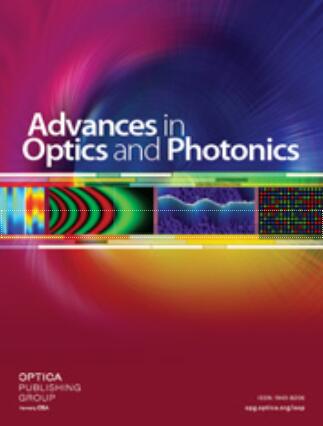Overcoming the diffraction limit by multi-photon interference: a tutorial
IF 23.8
1区 物理与天体物理
Q1 OPTICS
引用次数: 13
Abstract
The nature of light, extending from the optical to the x-ray regime, is reviewed from a diffraction point of view by comparing field-based statistical optics and photon-based quantum optics approaches. The topic is introduced by comparing historical diffraction concepts based on wave interference, Dirac’s notion of photon self-interference, Feynman’s interference of space–time photon probability amplitudes, and Glauber’s formulation of coherence functions based on photon detection. The concepts are elucidated by a review of how the semiclassical combination of the disparate photon and wave concepts have been used to describe light creation, diffraction, and detection. The origin of the fundamental diffraction limit is then discussed in both wave and photon pictures. By use of Feynman’s concept of probability amplitudes associated with independent photons, we show that quantum electrodynamics, the complete theory of light, reduces in lowest order to the conventional wave formalism of diffraction. As an introduction to multi-photon effects, we then review fundamental one- and two-photon experiments and detection schemes, in particular the seminal Hanbury Brown–Twiss experiment. The formal discourse of the paper starts with a treatment of first-order coherence theory. In first order, the statistical optics and quantum optics formulations of coherence are shown to be equivalent. This is elucidated by a discussion of Zernike’s powerful theorem of partial coherence propagation, a cornerstone of statistical optics, followed by its quantum derivation based on the interference of single-photon probability amplitudes. The treatment is then extended to second-order coherence theory, where the equivalence of wave and particle descriptions is shown to break down. This is illustrated by considering two photons whose space–time probability amplitudes are correlated through nonlinear birth processes, resulting in entanglement or cloning. In both cases, the two-photon diffraction patterns are shown to exhibit resolution below the conventional diffraction limit, defined by the one-photon diffraction patterns. The origin of the reduction is shown to arise from the interference of two-photon probability amplitudes. By comparing first- and second-order diffraction, it is shown that the conventional first-order concept of partial coherence with its limits of chaoticity and first-order coherence has the second-order analogue of partial entanglement, with its limits corresponding to two entangled photons (“entangled biphotons”) and two cloned photons (“cloned biphotons”), the latter being second-order coherent. The concept of cloned biphotons is extended to the case of n cloned photons, resulting in a 1/n reduction of the diffraction limit. In the limit of nth-order coherence, all photons within the nth-order collective state are shown to propagate on particle like trajectories, reproducing the 0th-order ray-optics picture. These results are discussed in terms of the linearity of quantum mechanics and Heisenberg’s space–momentum uncertainty principle. A general concept of coherence based on photon density is developed that in first order is equivalent to the conventional wave-based picture.用多光子干涉克服衍射极限:教程
通过比较基于场的统计光学和基于光子的量子光学方法,从衍射的角度回顾了从光学到x射线领域的光的性质。通过比较基于波干涉的历史衍射概念、狄拉克的光子自干涉概念、费曼的时空光子概率振幅干涉以及Glauber的基于光子检测的相干函数公式,介绍了该主题。这些概念是通过回顾不同光子和波概念的半经典组合如何被用于描述光的产生、衍射和检测来阐明的。然后在波和光子图片中讨论了基本衍射极限的起源。利用费曼关于与独立光子相关的概率振幅的概念,我们表明量子电动力学,即完整的光理论,以最低阶简化为传统的衍射波形式。作为多光子效应的介绍,我们随后回顾了基本的单光子和双光子实验和检测方案,特别是开创性的Hanbury-Brown–Twiss实验。本文的形式语篇从一阶连贯理论入手。在一阶中,相干的统计光学和量子光学公式是等价的。这是通过讨论Zernike的部分相干传播的强大定理来阐明的,该定理是统计光学的基石,然后是基于单光子概率振幅的干涉的量子推导。然后将该处理扩展到二阶相干理论,其中波和粒子描述的等价性被证明是崩溃的。这可以通过考虑两个光子来说明,这两个光子的时空概率幅度通过非线性生成过程相互关联,从而导致纠缠或克隆。在这两种情况下,双光子衍射图案显示出低于由单光子衍射图案定义的常规衍射极限的分辨率。减少的起源被证明是由双光子概率振幅的干扰引起的。通过比较一阶和二阶衍射,表明传统的一阶部分相干概念及其混沌性和一阶相干的极限具有部分纠缠的二阶相似性,其极限对应于两个纠缠光子(“纠缠双光子”)和两个克隆光子(“克隆双光子”,后者是二阶相干的。克隆双光子的概念被扩展到n个克隆光子的情况,导致衍射极限降低1/n。在n阶相干的极限下,n阶集体态内的所有光子都显示为在类粒子轨迹上传播,再现了0阶射线光学图像。这些结果是根据量子力学的线性和海森堡的空间-动量不确定性原理进行讨论的。提出了基于光子密度的相干性的一般概念,其一阶等效于传统的基于波的图像。
本文章由计算机程序翻译,如有差异,请以英文原文为准。
求助全文
约1分钟内获得全文
求助全文
来源期刊

Advances in Optics and Photonics
OPTICS-
CiteScore
56.60
自引率
0.00%
发文量
13
期刊介绍:
Advances in Optics and Photonics (AOP) is an all-electronic journal that publishes comprehensive review articles and multimedia tutorials. It is suitable for students, researchers, faculty, business professionals, and engineers interested in optics and photonics. The content of the journal covers advancements in these fields, ranging from fundamental science to engineering applications.
The journal aims to capture the most significant developments in optics and photonics. It achieves this through long review articles and comprehensive tutorials written by prominent and respected authors who are at the forefront of their fields.
The journal goes beyond traditional text-based articles by enhancing the content with multimedia elements, such as animation and video. This multimedia approach helps to enhance the understanding and visualization of complex concepts.
AOP offers dedicated article preparation and peer-review support to assist authors throughout the publication process. This support ensures that the articles meet the journal's standards and are well-received by readers.
Additionally, AOP welcomes comments on published review articles, encouraging further discussions and insights from the scientific community.
In summary, Advances in Optics and Photonics is a comprehensive journal that provides authoritative and accessible content on advancements in optics and photonics. With its diverse range of articles, multimedia enhancements, and dedicated support, AOP serves as a valuable resource for professionals and researchers in these fields.
 求助内容:
求助内容: 应助结果提醒方式:
应助结果提醒方式:


